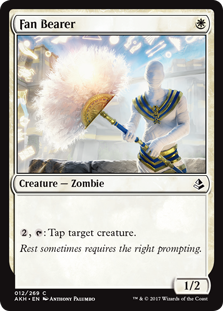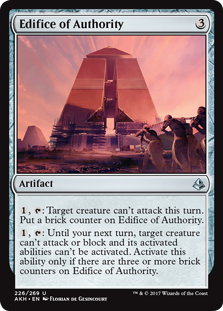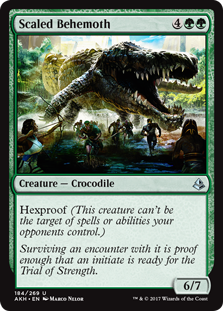For two weeks out of the year, Sealed RPTQs provide a chance to qualify for the pro tour. Lucky for us, that time is now. Amonkhet has proven to be a deep and rewarding Limited format. Draft has gotten most of the attention, but I’ve found Sealed to be deeper and more interesting than usual. What started out as an unusually fast Sealed format has evolved into a complex, powerful, swingy format that greatly rewards deck construction and strategic execution.
Last week, Chantelle wrote a good quick rundown of the competitive Sealed format. I’m hesitant to take the draw against an unknown opponent, but otherwise I’m on the same page as her. If you want a thorough examination of how to succeed in Amonkhet Sealed, I recommend this great primer by seventeenth-ranked pro Eduardo Sajgalik. Seriously, go read it. Unless you’re playing in the Missouri RPTQ this Sunday, in which case please do no preparation at all.
Everyone agrees that this format is dominated by its rares and mythic rares, a “Prince” format in Brian David-Marshall’s Prince/Pauper designation. This is true enough—there are some ridiculous rares out there, many that cost five mana and fly. But for my money, the rares define the games but do not necssarily end them. I’ve lost multiple games of Sealed where I exerted a [casthaven]Glorybringer[/casthaven] twice. And I’ve won games where I ground out victory by trading off both sides of both copies of [casthaven]Glyph Keeper[/casthaven] in my pool. Unlike Born of the Gods, where a resolved bomb like [casthaven]Citadel Siege[/casthaven][casthaven][/casthaven] basically meant game over, the Amonkhet bombs lead to challenging decisions and interesting games.
There’s a lot you can do with lower-rarity cards, however. It helps to have the bombs, but you need to build a deck around them, or without them if you must. Below I highlight six cards (and some of their friends) that I hope to see in my Sealed pools and that do a ton of work in the format.
Not surprising news here, but [casthaven]Fan Bearer[/casthaven] is a premium common in Sealed. Despite many aggressive starts, games of Amonkhet Sealed tend to go long. Players trade powerful cards back and forth, and hitting land drops becomes important. Many people focus on sixteen or fifteen land Sealed decks with all the aggression and cycling, but I think that it is a mistake to think of Amonkhet Sealed as a format that doesn’t want plenty of mana. Cycling makes your deck effectively smaller, allowing fewer lands to provide a normal ratio in practice. But you still need to play lands—and one of the big reasons is so you can afford to activate [casthaven]Fan Bearer[/casthaven].
You can cast every spell in the set using [casthaven]Gift of Paradise[/casthaven], assuming you have enough generic mana to pay the full cost. Sure, you can’t technically cast [casthaven]Enigma Drake[/casthaven] off two forests and Gift, but as a practical matter providing two mana of any one color basically does the [casthaven]Oath of Nissa[/casthaven] thing where the colors of mana you spend don’t matter. It’s pretty hard to depend on one copy, but [casthaven]Gift of Paradise[/casthaven] is common—if you have two or three, you can cast literally any card in your pool. Many, many bombs cost two mana of a specific color. If you have the gift, your deck will have all the power you can muster.
Other mana fixing cards also go up in value because the format is slow enough that you can wait to hit a splash color. [casthaven]Evolving Wilds[/casthaven] is a premium common, but even [casthaven]Painted Bluffs[/casthaven] is playable. Curving out isn’t as important in Sealed as being able to cast your spells, so you can afford to run the risk of adding a mana to your spells. [casthaven]Painted Bluffs[/casthaven] also helps specifically to splash spells like [casthaven]Magma Spray[/casthaven], an effect you’d be glad to pay two mana for against most decks. Also note, both [casthaven]Painted Bluffs[/casthaven] and [casthaven]Cascading Cataracts[/casthaven] let [casthaven]Naga Vitalist[/casthaven] tap for any color of mana.
No surprise here. Icy Manipulator is a powerful card even after all these years. It’s so frustrating to face off against this card. It’s even better than [casthaven]Fan Bearer[/casthaven] in most decks. Obviously it’s colorless, but once you get it going, it costs less mana each turn. Plus, it doesn’t tap the opposing creature; unlike [casthaven]Fan Bearer[/casthaven], it doesn’t struggle against [casthaven]Vizier of Tumbling Sands[/casthaven]. It’s worth playing [casthaven]Dissenter’s Deliverance[/casthaven] or [casthaven]Forsake the Worldly[/casthaven] in your main deck becase you’ll see a lot of Edifices over the course of a long tournament.
Big and close to unkillable. All of the big green dinosaurs are strong in Sealed, and [casthaven]Scaled Behemoth[/casthaven] is the champion of champions. You can do some good work with this giant and some cartouches, but you don’t need to do much other than stretch out the game and then drop this on the board. I essentially consider [casthaven]Scaled Behemoth[/casthaven] a rare bomb—it’s a good reason to play green. In theory you could splash it off [casthaven]Gift of Paradise[/casthaven] like you would any other double-color bomb, but it’s already in the same color as Gift. In one or two Sealed pools I left this on the sidelines, but I felt bad and was probably wrong.
Creature recursion is one of the secret underrated effects for Sealed. Like counterspells and discard, recursion gets better when games slow down from Draft to Sealed. So many games become attrition wars, where restocking with your two best creatures can seal victory. Other games revolve around answering their one or two problem threats. The other day, I faced an opponent who returned [casthaven]Regal Caracal[/casthaven] to her hand and replayed it four times in a single game. I put up a good fight, but come on.
Wander in Death frustrates opponents and crushes comeback hopes. Plus it has cycling, which makes it incredibly versatile. If you’re playing a slower deck with any mana fixing, I’d splash [casthaven]Wander in Death[/casthaven] regardless of your colors. The effect is especially valuable if your opponent gives you opportunities to trade creatures. If in game one they always attack into your board when you’re tapped out, you should bring in [casthaven]Wander in Death[/casthaven] if it isn’t already in your deck. The best way to win in Magic is to play cards that simultaneously advance your game plan while hindering your opponent’s plan. In an attrition-based Sealed format, rebuying two creatures with one card does exactly that.
People like to slag on blue in this format, but I like it just fine for Sealed. Counterspells and card draw are very good, as are big fliers and embalm creatures. But what’s the blue card I really want? [casthaven]Mind Control[/casthaven]. You can take anything with this—though don’t try taking their [casthaven]Cruel Reality[/casthaven], as few auras care who controls them. [casthaven]Greater Sandwurm[/casthaven] is a strong Sealed finisher. [casthaven]Lay Claim[/casthaven] is essentially the same card with greater upside. If your opponent doesn’t how single powerful cards you can side it out, but this seven-mana bomb is worth playing if you can and splashing if necessary. Once again, [casthaven]Gift of Paradise[/casthaven] comes in handy here.
If you’re playing in an RPTQ this weekend or heading the Grand Prix Las Vegas next week, good luck. Enjoy the opportunity to compete in a deep and rewarding Limited environment in its mature stage. That is a rare treat.
Carrie O’Hara is Editor-in-Chief of Hipsters of the Coast.









